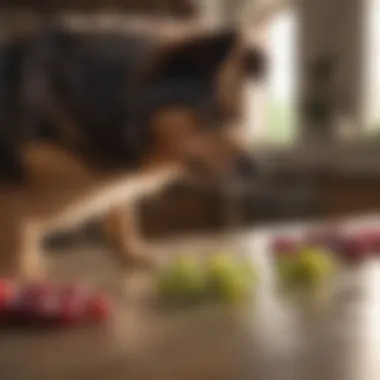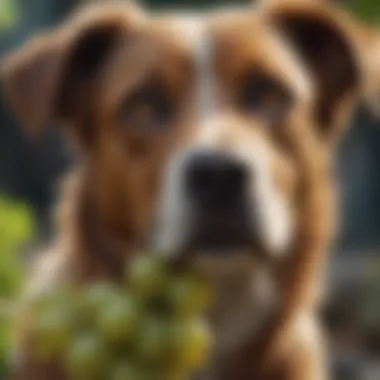The Dangers of Grapes: Why Dogs Should Avoid Them


Intro
Understanding why certain foods can be dangerous for our beloved pets is crucial for ensuring their health and well-being. This is particularly true when discussing grapes, which many people might assume are safe to feed to their dogs. However, the reality is that grapes and their dried counterparts, raisins, pose a significant risk to canine health. This article will delve into the toxicological aspects of grapes, their health impacts on dogs, preventive measures for pet owners, and suitable treat alternatives. By compiling existing research and expert opinions, pet owners can better navigate the dietary choices for their dogs.
Animal Species Profile
Intro to the Animal Species
Dogs, or Canis lupus familiaris, come in various breeds and sizes, reflecting a long history of selective breeding for different uses. They are part of the domesticated animal group and hold a place as one of the most common pets worldwide. With their unique traits, dogs bring companionship and loyalty to countless homes.
Physical Characteristics and Appearance
Dogs showcase a broad range of physical characteristics. Their size can vary from tiny breeds, like Chihuahuas, to large breeds such as Great Danes. The coat can be short, long, or curly, with colors ranging from solid tones to complex patterns. Each dog is unique, displaying variations that reflect their breed, including differing ear shapes and tail lengths.
Natural Habitat and Distribution
Originally, dogs were domesticated from wolves. Over time, they adapted to human environments, leading them to thrive in urban, suburban, and rural settings alike. As non-feral canines, their natural habitats have evolved to coexist with people.
Behavior and Social Interactions
Dogs are social animals by nature. They crave interaction with both humans and other animals. In a pack or family setting, dogs often communicate using vocal cues, body language, and even facial expressions. Their ability to form bonds creates a unique dynmics within their groups.
Health Risks Associated with Grapes
When considering dietary choices for dogs, it's important to remember that not all foods are safe. Grapes can cause kidney failure in dogs, even in small amounts. The exact toxic component in grapes remains unknown, adding an element of caution. Both fresh grapes and raisins are harmful; pet ownership cannot overlook this point.
Even a few grapes or raisins can lead to serious health consequences for dogs.
Symptoms of Grape Toxicity
Recognizing the signs of grape toxicity is crucial. Symptoms to look for include:
- Vomiting
- Diarrhea
- Lethargy
- Loss of appetite
- Abdominal pain
If a pet owner suspects their dog has ingested grapes, swift action is necessary. Timing significantly affects outcomes, and seeking veterinary care is essential and should not be delayed.
Alternative Treats for Dogs
Instead of grapes, dog owners can consider safe alternatives such as:
- Carrots
- Blueberries
- Apples (without seeds)
- Peaches (without pits)
These fruits can provide nutrition without the risk associated with grapes. Each alternative offers benefits necessary for a dog’s health.
Preventive Measures for Pet Owners
Understanding the potential hazards of certain foods is vital. Educating oneself about which foods to avoid is a great step in safeguarding pets. Simply keeping grapes and raisins out of reach and being conscious of treats can help prevent adverse reactions. Consider reading labels before offering any snacks to dogs. Additionally, awareness when interacting with others (friends or families) who may not understand the risks can protect furry companions from misfortune.
Summary
Grapes pose a significant risk to dogs, leading to serious health issues. By understanding the dangers and being proactive in avoiding these fruits, pet owners are better equipped to maintain dog well-being. Not only does this knowledge include awareness of toxic foods, but also involves finding safe treat alternatives. Ultimately, keeping pets safe involves education, vigilance, and responsible dietary choices as central themes. Information gathered from studies will remain essential in creating a holistic approach for caring for dogs.


Prelude to Canine Dietary Restrictions
Understanding the dietary restrictions of dogs is essential for every responsible pet owner. As animals closely associated with humans, dogs share our living spaces and, in many cases, our food. However, not all human foods are safe for canine consumption. The importance lies in recognizing the specific dietary needs of dogs, which can differ markedly from our own. Eating the wrong type of food can lead to serious health consequences, ranging from mild gastrointestinal upset to severe toxicity that can threaten a dog's life.
Overview of Toxic Foods for Dogs
The list of toxic foods for dogs is significant. Some common items include chocolate, onions, garlic, and, notably, grapes. The consequences of misjudging a snack can be dire. Issues caused by high-fat human foods, like avocados and macadamia nuts, also warrant careful consideration. Dogs can behave differently towards these substances due to their unique metabolic systems.
It is hammering critical for dog owners to familiarize themselves with such toxicity to mitigate risks associated with acute poisonings. Understanding which foods harm them can help create an ideal diet. Recording these detrimental foods ensures wellbeing for your canine companion.
Importance of Understanding Food Risks
Mapping out the risks related to common household foods is essential for longevity and health in our pets. Simply knowing what not to feed them is not enough. Pet owners must also grasp how and why certain foods can induce adverse effects. For instance, kidneys in dogs are particularly vulnerable to certain toxins, making awareness very crucial. Grape consumption can lead to renal failure, as even a small amount may have dreadful consequences.
Educating oneself about the specific food risks provides the foundation for responsible pet ownership. Decode how foods react in a dog’s system helps prepare owners for emergencies. With proper knowledge, timely decisions can save a dog's life in cases of accidental ingestion.
“Understanding food hazards ultimately enables dog owners to act quickly when potential risks arise, protecting their pets.”
Grapes and Their Toxicity in Dogs
Understanding the effects of specific foods, like grapes, on canine health is crucial for dog owners. Research continues to emerge regarding toxic subtances for pets, and grapes stand out as particularly harmful despite their seeming innocuous nature. Many pet owners are unaware that routine human snacks can lead to serious consequences for their furry companions. Thus, examining the significance of grapes and their toxic effects opens a dialogue on the critical nature of pet dietary restrictions. It emphasizes the responsibility dog owners have in curating a safe eating environment for their pets.
Scientific Findings
Numerous studies have documented that grapes and raisins can cause acute kidney failure in dogs. One landmark study initiated by veterinarians showcased the correlation between grape ingestion and renal issues in canines. Not all dogs show sensitivity to grapes; differences in genetic predisposition and individual health status can impact the severity of the effects. However, the consensus among veterinary experts is that these fruits pose a high risk, making any ingestion cause for serious concern.
Research indicates that even a small amount can induce severe toxic reactions in susceptible breeds.
Even though the exact toxin within grapes has not been conclusively identified, the clinical manifestations help outline their dangers. Affected dogs may later exhibit signs such as vomiting, diarrhea, lethargy, or reduced urine output. Monitoring these symptoms post-exposure is essential in making informed decisions regarding treatment options.
Although findings are varied, there is a growing body of evidence that suggests potential risk even when dogs have ingested grapes without immediate adverse effects. What this signifies for dog owners is the necessity to remain aware and cautious with their protein and snacking choices around dogs, fostering a proactive approach to pet care.
Types of Grapes and Raisins
Grapes come in many varieties, but all types pose similar risks for dogs. Red grapes, green grapes, seedless grapes, and even dried forms such as raisins are all dangerous when consumed by dogs. The lack of recognized differences in toxicity among these types can be shocking. For example, some owners may believe that dried raisins are less harmful simply due to their status as snacks. This notion is perilous since drying does not eliminate the toxic properties.
Additionally, all around the world, grapes are connected to common snacks in various cultures. This ubiquitous nature emphasizes the need for caution; dog owners must ensure that grapes, whether whole or in various food products, remain out of reach. A few important tips include:
- Carefully check the ingredients of any human snacks shared with dogs.
- Educate family members about the myriad dangers of certain foods.
- Commit to keeping fictional foods at a reasonable distance during mealtime preparations.
Highlighting both the research findings and the varieties of grapes helps inform pet owners. Staying educated can make a monumental difference in dog safety and wellness.
Mechanism of Toxicity
Understanding the mechanism of toxicity in relation to grapes is essential for dog owners. The knowledge about how grapes impact canine health symbolizes a proactive defense against potential poisoning situations. Identifying the nature of toxins found in grapes and their biology equips pet owners with tools for swift decision-making in case of ingestion. The connection between diet and health in dogs is profound and knowing these details will aid many care decisions towards safety.
Identifying the Toxin
Research into why grapes are dangerous presents several variables. Currently, researchers have not isolated a singular toxin responsible for grape toxicity in dogs. Substances within grapes like 2-[(3-phenylphenyl)methyl]benzoic acid are deemed suspect, but understanding precisely how they affect dogs remains under examination. Such unidentified components can pose risks differing between individuals, showing no predictable patterns in responses to various amounts .
Studies affirm that small quantities of grapes can produce symptoms leading to potential renal failure. The variation in sensitivity points to a personalized consideration among dogs. For instance, breeds or dogs with preexisting health issues may react stronger to exposure.


Research remains ongoing, and dog owners must remain aware and cautious regarding their pets' diet that includes grapes.
Pathophysiology of Grape Toxicity
When a dog ingests grapes, the complicated processes start immediately within its body. Pathophysiologically, the induction of acute kidney injury fractionates into several crucial areas. This can present as sudden nausea, vomiting, and loss of appetite. Ultimately, canine acuteness to toxic substances leads to expected delays or dysfunction in renal functionality.
A significant mechanism that might lead to complications stems from oxidative stress. This often occurs through the increased generation of oxidants beyond the dog's managing capacities. The often pernicious behavior from grapes results in feelings of lethargy, attracting increased medical attention.
Management of exposure revolves around treatment diversity focused on hydration and filtration. Hospitalization sometimes becomes necessary, especially when symptomatic power rises. The physiology of canine beings and the interplay of toxic elements as those from grapes engenders a persuasive discussion about dietery prudence for dogs within pet ownership today.
Symptoms of Grape Poisoning in Dogs
Understanding the symptoms of grape poisoning in dogs is crucial for all dog owners. This section outlines various reactions dogs may exhibit after consuming grapes or raisins. Recognizing these symptoms can potentially save a dog's life, as timely action can mitigate severe health consequences.
When dogs ingest grapes, the effects can vary widely based on factors such as the amount consumed, individual sensitivities, and health conditions. Observing key indicators can lead to quicker intervention, which is essential in poisoning cases.
Early Signs to Watch For
It’s vital for dog owners to monitor their pets closely for early symptoms of grape poisoning. Some initial signs may include:
- Vomiting: This is often one of the first signs to appear after ingestion. Vomiting may occur within hours.
- Diarrhea: Loose stools can also be frequent with grape exposure.
- Lethargy: Dogs may seem unusually tired or sluggish, not displaying their typical energy.
- Reduced appetite: A sudden disinterest in food might be noticeable.
- Abdominal pain: Dogs might show signs of discomfort, such as whining or refusing to be touched.
It’s essential to act promptly if your dog shows any of these signs. A quick call to a veterinarian is advisable. Taking action can prevent further complications.
Severe Reactions and Long-term Effects
In some cases, behaviors will escalate rapidly after initial signs. Heavy grape poisoning results in serious health issues.
- Acute kidney failure: This condition develops in many affected dogs within a few days of ingestion and can manifest as severe anuria or urinary issues.
- Seizures: Neurological symptoms like seizure activity can occur from systemic effects.
- Coma or sudden death: In severe cases, dogs can collapse, becoming non-responsive due to critical internal injuries.
- Long-term kidney damage: Some dogs may recover but suffer with long-lasting effects.
Research shows a direct correlation between grape consumption and kidney function decline in canines.
Active monitoring and irregularly too long seen signs warrant veterinary consultation. Without necessary action, serious complications could result in definitive health issues or worse outcomes. Dog owners must prioritize awareness. Understanding potential symptoms can directly contribute to better health outcomes for pets.
Diagnosis and Treatment Options
Understanding the diagnosis and treatment options for dogs that have been exposed to grapes is vital for ensuring their health and safety. Grapes and raisins have been consistently associated with acute kidney injury in dogs, relating to unidentified toxins present in these fruits. When a dog accidentally consumes even a small quantity, swift action is crucial.
Identifying the symptoms early on can significantly improve outcomes for affected pets. Alongside this, knowledge of veterinary protocols significantly aids in confirming wrong diagnosis or ruling out other health concerns.
Veterinary Diagnostic Protocols
When a dog displays any signs of grape poisoning, the first step is to seek veterinary care immediately. Vets typically employ various diagnostic tools to assess the extent of potential poisoning:
- Medical History Assessment: Understanding when and how much the dog consumed is critical. The owner should provide as much detail as possible.
- Blood Tests: These are pertinent for measuring kidney function. Levels of blood urea nitrogen (BUN) and creatinine are markers that help evaluate any renal damage.
- Urinalysis: This test checks for changes in urine inconsistent with healthy kidney function. Abnormal results may suggest severe exposure.
- Physical Examination: Through this, vets can assess hydration levels and check for vomiting, lethargy, and lethargy, which are indicative of toxicity.
Early diagnosis allows for prompt treatment. Assistance to a facility equipped for emergency care can enhance positive health outcomes for dogs.
Treatment Approaches Post-Exposure
Once diagnostic tests confirm exposure and resultant toxicity, treatment options become the main focus. Key approaches often involve:


- Induced Vomiting: If the consumption is recent enough, a vet may induce vomiting. This procedure helps to eliminate any grapes still in the stomach, lessening chances of absorption into the bloodstream.
- Activated Charcoal Administration: This may be administered to mitigate further absorption of the toxin that might remain within the digestive tract.
- Fluid Therapy: Intravenous fluids are often essential. They help flush out the kidneys and maintain hydration, which is critical when a dog shows signs of renal damage.
- Monitoring and Support Care: Continuous monitoring at a veterinary facility can help detect worsening conditions. Supportive measures involve corticosteroids and medication for kidney support, which help manage inflammation.
Timely intervention significantly increases paycheck-related positive impacts of canine kidney-related issues.
Through combining these strategies, effective treatment increases the chance of recovery. The outcome frequently relies on how soon care is sought after exposure to grapes.
Preventive Measures for Dog Owners
Understanding the potential risks associated with grapes is crucial for pet owners. Preventive measures can decisively influence a dog’s health and well-being by safeguarding them from uneccessary exposure to potentially hazardous foods. The focus here is to establish a proative mindset that not only considers individual canine dietary needs but also gathers a family unit unde resources to mitigate risk and keep our pets safe.
Creating a Safe Environment
One of the fundamental pillars of preventing grape-related toxicity in dogs is to create a safe environment. This includes removing all grape containing foods from places accessible to your pet. Kitchen countertops, dining tables and even on-the-go snacks need careful management. Dog owners should consider adopting the following strategies:
- Keep grapes and raisins securely stored far from reach.
- Be cautious of food swings, picnics and barbeques where grapes may be lying around.
- Train your dog to obey basic commands like "leave it," which can prevent them from ingesting dangerous foods.
Establishing rules for safe areas in and around your home helps prevent accidents. Always be alert and avoid distraction, especially when eating or entertaining.
Educating Family Members
Educating everyone in your household about the dangers of grapes to dogs is essential. If a family member does not understand the risks, it becomes easier for a mishap to occur. Clear communication among all is crucial. Consider the following:
- Hold a quick family meeting to discuss which foods are toxic. Reinforce the importance of rigorous food safety around pets.
- Provide neat guidelines of safe and unsafe foods and place them where noticeable.
- Encourage all family members, including young children, to prevent sharing harmful items with pets and how to respond in case of ingestion.
Implementation of these soli steps not only increases familial awareness but also fosters collective responsibiliity for the well-being of the canine members of your family. By spreading knowledge and awareness, you substantially lower the risk of your dog consuming harmful items like grapes.
Alternatives to Grapes for Treats
When considering the diet of our canine friends, knowing which treats are safe is critical. While grapes might seem like an innocent snack, their dangerous effects warrant careful consideration. Thankfully, there are numerous alternative treats that are safe and healthy for dogs. Understanding these substitutes is vital for any responsible pet owner.
Safe Fruits for Dogs
Fruits can offer a refreshing and nutritious treat for dogs that provides vital vitamins, minerals, and calories. Some safe options include:
- Apples: Remove seeds and core before giving to your dog.
- Bananas: These are full of potassium, great for energy and digestion.
- Blueberries: A high antioxidant source, they can improve brain health and digestion.
- Cucumbers: Though technically a vegetable, many dogs enjoy these crunchy snacks which have low calories.
- Watermelon: Make sure to remove the seeds and rind. This fruit is refreshing and hydrating for hot days.
These safe fruits are not just tasty but also beneficial for your pet's health. When introducing these fruits, moderation is key. Too many can upset a dog's stomach.
Healthy Snack Options
Ensuring that dogs have a diverse diet with great nutritional value can be easily done through various healthy snack options. Here are some suggestions:
- Carrots: Fresh and crunchy, these are great for teeth and low in calories.
- Pumpkin: Canned pumpkin (not pie filling) can aid digestion and is a source of fiber.
- Peanut Butter: This can act as a tasty reward but always opt for xylitol-free brands.
- Yogurt: Plain, unsweetened yogurt can be a good source of calcium and probiotics but check for lactose tolerance.
- Sweet Potatoes: Dehydrated or cooked, they offer vitamins A and C, plus fiber.
These alternative treats fulfill both cravings and dietary needs while steering clear of grape-related hazards. They also present a chance for pet owners to explore creative element while understandng the variations in their dog's preferences.
Ending
Understanding the reasons why grapes are harmful to dogs is essential for pet owners. This article explores the critical points pertaining to grape toxicity, safe dietary practices, and alternative treat options. Grapes, despite their seemingly harmless appearance, can trigger severe health issues in dogs. Knowledge of these dangers helps owners to make informed choices each day.
In summary, pet owners must recognize that the risks associated with cional aspects of grapes extend beyond simple sweetness. Being aware of these concerns can significantly improve canine well-being. By prioritizing safe snacks and creating a nurturing environment, dogs can enjoy a happy, healthy life devoid of harmful foods.
Key takeways can allow non-expert dog owners to better assess potential dietary black spots that they might be unknowingly exposing their pets to.
Summary of Key Points
- Grapes are toxic to dogs, with both grapes and raisins posing health risks.
- Different types of grapes may ultimately have varying effects, thus caution is warranted.
- Early symptoms of poisoning include vomiting, lethargy, and decreased appetite.
- Diagnosis involves a veterinary check followed by potential treatment, such as inducing vomiting.
- Alternatives to grapes, including suitable fruits, offer great and safe options for rewarding dogs.







